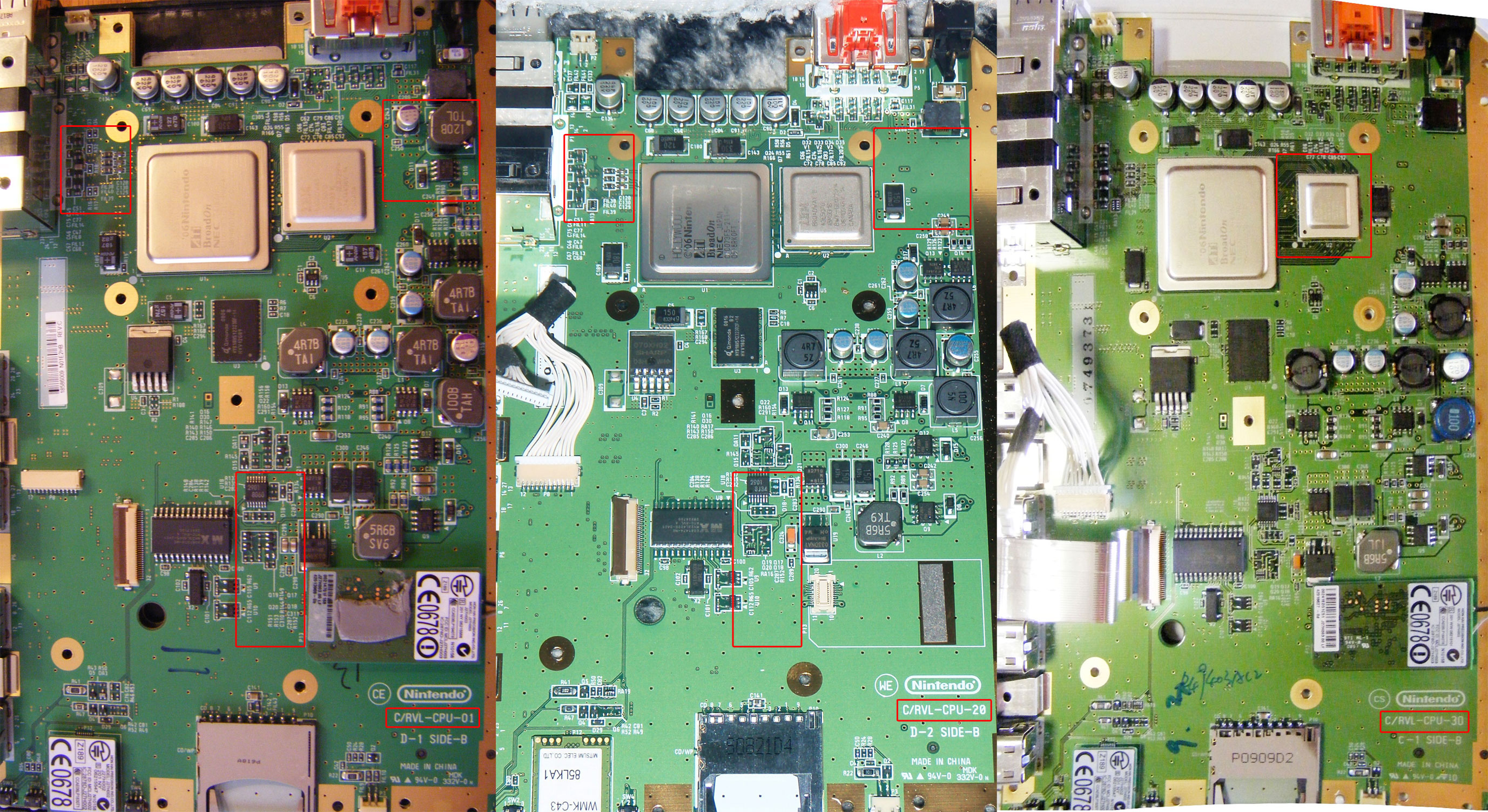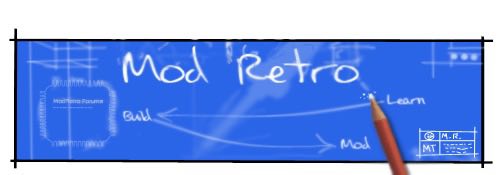Shank
Formerly Known As Dyxlesci
Prologue:
I initially joined the modretro community wanting to make a simple wii portable. But then I decided to go overkill. What started as a simple mod has had me attempting to deconstruct the wii to find as much information in the uncharted sea that is wii portablizing. The Wii has so much untapped potential.
Along the way, I met Blargaman, and he and I have set on the ambitious task of trimming the Wii to its limits. His electrical engineering knowledge has been invaluable along the way, and I would like to start out that this is all as much his findings as it is mine. Not much information has been documented on the wii and its many revisions, and people gave up on the wii upon discovering how may layers the boards have, and how many hidden traces wait to be severed.
The wii is cheap today. I have been able to get wiis for $15 or less on a regular basis. I have gone between 15-20 wiis in the past few months, most of which have not survived surgery. The disc drives are still worth a decent amount of money, so those can be sold to recover costs.
Our work is not done, but I am sick in bed and decided this would be a good opportunity to share our findings. Please note all testing and information is about NTSC wiis and may or may not apply to other regions.
THE DISCOVERIES:
The die shrink: Nintendo actually performed a die shrink on the wii back in 2009, dropping the cpu from 90nm to 65nm.

Image curtesy of hackmii.
This makes a world of difference, especially in reducing power consumption. But how much? Heres the power consumption of both iterations of the wii under the same conditions.
90nm Wii: ~12v 1.3A
65nm Wii: ~12v .8A
That is approximately a 40% reduction in power consumption. So systems using this new chip will accomplish the same tasks while consuming much less power and creating much less heat. This is great news for portablizers
To which Wiis does this apply? Heres a timeline:
November 19, 2006: Wii (90nm) goes on sale, exclusively in White
~2008-2009: Nintendo switches over to 65nm chips (exact date unconfirmed)
May 9, 2010: Wii is released in black, sold alongside white wii
October 23, 2011: Wii family edition is launched
November 17, 2013: Wii mini Launches
By this timeline, we can confirm:
All Wii consoles without gamecube controller ports have the die shrunk chip.
All Black Wiis (including ones with gamecube controller ports) have die shrunk chip
SOME White Wiis have die shrunk chips.
I currently know of no way to tell if a white wii is the correct revision from the outside. As of now, I have to take it apart to find this information out.
TL;DR: Buying a black wii with gamecube controller ports ensures you get both an efficient chip and gamecube compatibility.
CUTTING:
While I have been looking into the cpu, figuring out how to buy the right revision, and comparisons between boards, Blargaman has been busy looking into trimming possibilities. I have sent him package after package of wii boards and he has used his Dremel to unearth some interesting discoveries.
Although the RVL-CPU-30 features a die shrunk cpu, its board contains many layers and hidden traces, making significant trimming almost impossible. For the longest time, this was believed to be the case for all Wiis.

RVL-CPU-30, featuring hidden layers and traces waiting to short you when you least expected.
Blargaman later discovered an even newer revision of the wii: the RVL-CPU-40

I have a cpu-30 with a date of 0902, and a cpu-40 with a date of 0909, so the cpu-40 began production some time between the 2nd and 9th week of 2009. The date of production digits can be found in the bottom left corner of both the cpu and gpu, along with some sd card slots and other components, depending on the revision.
With visible traces, and less layers, this board is a dream come true. Blargaman has had phenomenal progress trimming this board.
Here is a picture of a working trim of his. I see a bright future for the wii.

TL;DR RVL-CPU-40 is the best to use. It features less layers, and more of the traces are visible. It is used in every single black wii with gamecube ports.
****UPDATE 1****
IDENTIFYING:
You can remove the bios battery tray to view the motherboard revision without disassembling your system. Simply remove the single screw, slide out the tray, and read the 2 digit number (01, 20, 30, 40, 60 or another yet to be discovered revision)
ALBUM OF WII BOARDS
http://imgur.com/a/npLbg
PICTURES FROM EBAY
I drank a coke before going to bed. So I am awake. I went on ebay and found pictures of 2 boards I don't have documentation on. I have contacted a seller to see if he will take pictures of his boards for me.
http://imgur.com/a/tKwSd
This is a WIP, and I would love any and all feedback or new information.
I initially joined the modretro community wanting to make a simple wii portable. But then I decided to go overkill. What started as a simple mod has had me attempting to deconstruct the wii to find as much information in the uncharted sea that is wii portablizing. The Wii has so much untapped potential.
Along the way, I met Blargaman, and he and I have set on the ambitious task of trimming the Wii to its limits. His electrical engineering knowledge has been invaluable along the way, and I would like to start out that this is all as much his findings as it is mine. Not much information has been documented on the wii and its many revisions, and people gave up on the wii upon discovering how may layers the boards have, and how many hidden traces wait to be severed.
The wii is cheap today. I have been able to get wiis for $15 or less on a regular basis. I have gone between 15-20 wiis in the past few months, most of which have not survived surgery. The disc drives are still worth a decent amount of money, so those can be sold to recover costs.
Our work is not done, but I am sick in bed and decided this would be a good opportunity to share our findings. Please note all testing and information is about NTSC wiis and may or may not apply to other regions.
THE DISCOVERIES:
The die shrink: Nintendo actually performed a die shrink on the wii back in 2009, dropping the cpu from 90nm to 65nm.

Image curtesy of hackmii.
This makes a world of difference, especially in reducing power consumption. But how much? Heres the power consumption of both iterations of the wii under the same conditions.
90nm Wii: ~12v 1.3A
65nm Wii: ~12v .8A
That is approximately a 40% reduction in power consumption. So systems using this new chip will accomplish the same tasks while consuming much less power and creating much less heat. This is great news for portablizers
To which Wiis does this apply? Heres a timeline:
November 19, 2006: Wii (90nm) goes on sale, exclusively in White
~2008-2009: Nintendo switches over to 65nm chips (exact date unconfirmed)
May 9, 2010: Wii is released in black, sold alongside white wii
October 23, 2011: Wii family edition is launched
November 17, 2013: Wii mini Launches
By this timeline, we can confirm:
All Wii consoles without gamecube controller ports have the die shrunk chip.
All Black Wiis (including ones with gamecube controller ports) have die shrunk chip
SOME White Wiis have die shrunk chips.
I currently know of no way to tell if a white wii is the correct revision from the outside. As of now, I have to take it apart to find this information out.
TL;DR: Buying a black wii with gamecube controller ports ensures you get both an efficient chip and gamecube compatibility.
CUTTING:
While I have been looking into the cpu, figuring out how to buy the right revision, and comparisons between boards, Blargaman has been busy looking into trimming possibilities. I have sent him package after package of wii boards and he has used his Dremel to unearth some interesting discoveries.
Although the RVL-CPU-30 features a die shrunk cpu, its board contains many layers and hidden traces, making significant trimming almost impossible. For the longest time, this was believed to be the case for all Wiis.

RVL-CPU-30, featuring hidden layers and traces waiting to short you when you least expected.
Blargaman later discovered an even newer revision of the wii: the RVL-CPU-40

I have a cpu-30 with a date of 0902, and a cpu-40 with a date of 0909, so the cpu-40 began production some time between the 2nd and 9th week of 2009. The date of production digits can be found in the bottom left corner of both the cpu and gpu, along with some sd card slots and other components, depending on the revision.
With visible traces, and less layers, this board is a dream come true. Blargaman has had phenomenal progress trimming this board.
Here is a picture of a working trim of his. I see a bright future for the wii.

TL;DR RVL-CPU-40 is the best to use. It features less layers, and more of the traces are visible. It is used in every single black wii with gamecube ports.
****UPDATE 1****
IDENTIFYING:
You can remove the bios battery tray to view the motherboard revision without disassembling your system. Simply remove the single screw, slide out the tray, and read the 2 digit number (01, 20, 30, 40, 60 or another yet to be discovered revision)
ALBUM OF WII BOARDS
http://imgur.com/a/npLbg
PICTURES FROM EBAY
I drank a coke before going to bed. So I am awake. I went on ebay and found pictures of 2 boards I don't have documentation on. I have contacted a seller to see if he will take pictures of his boards for me.
http://imgur.com/a/tKwSd
This is a WIP, and I would love any and all feedback or new information.


